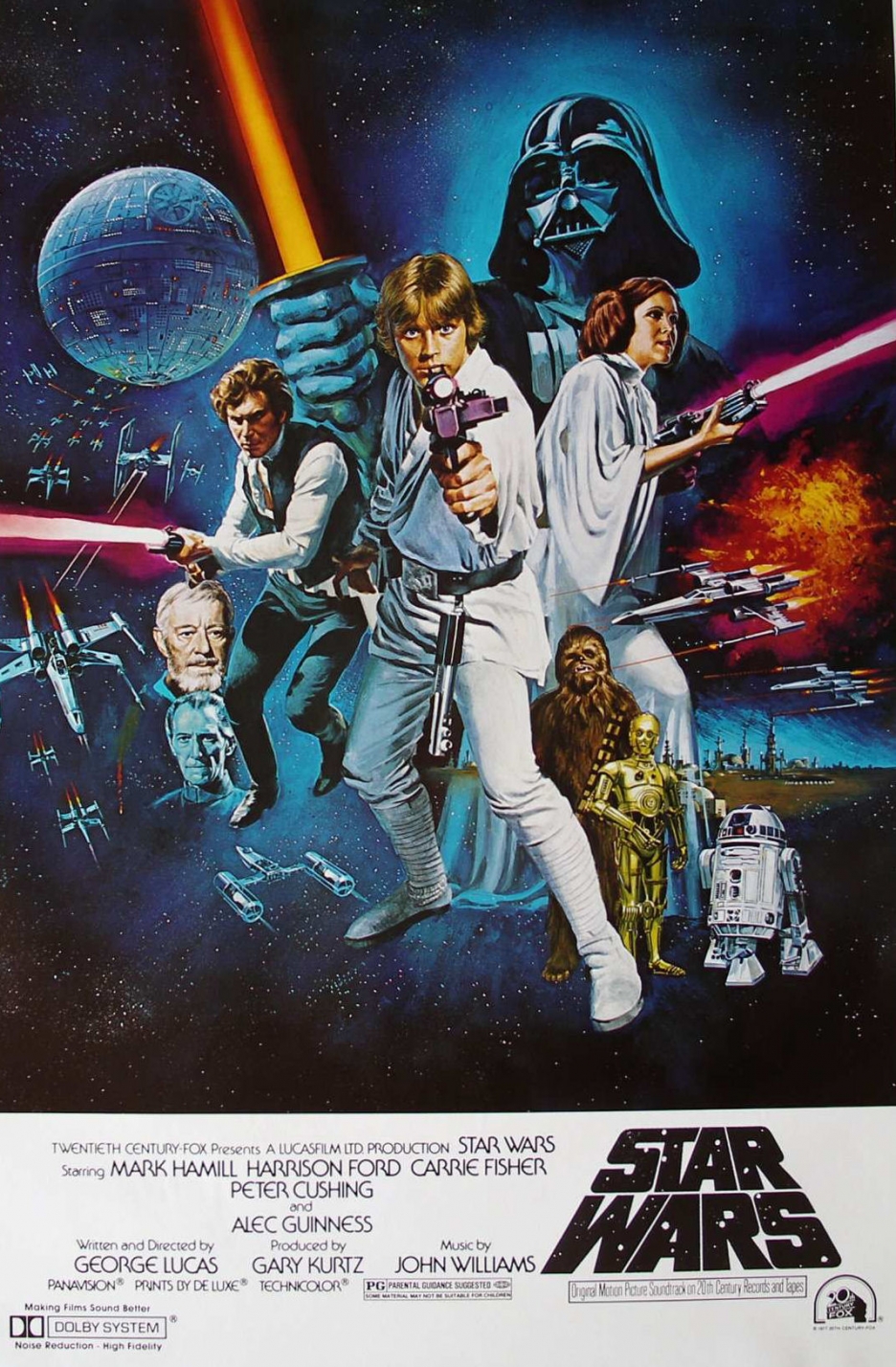NOTE: This article may contain spoilers for those who have not watched the films.
As of this writing, there is only about one week until Star Wars Episode VII – The Force Awakens hits theaters. After a decade of waiting and plenty of other assorted news regarding everyone’s favorite Galaxy Far Far Away, a new feature film is on the horizon!
With the release of the new film just around the corner, this fan thought it would be a good time and look at the six Star Wars feature films released so far. We will look at both the Classic Trilogy, released from 1977-1983, and the Prequel Trilogy, released from 1999-2005. It is time to look at the highs and lows of the series, some of the controversial revisions and additions to the series, and even some rare trivia you might not have known about the movies.
Note: Changes made to films in one edition/release are generally retained in all subsequent releases. Also, the changes sections are NOT all-inclusive.
Star Wars Episode IV: A New Hope (1977)
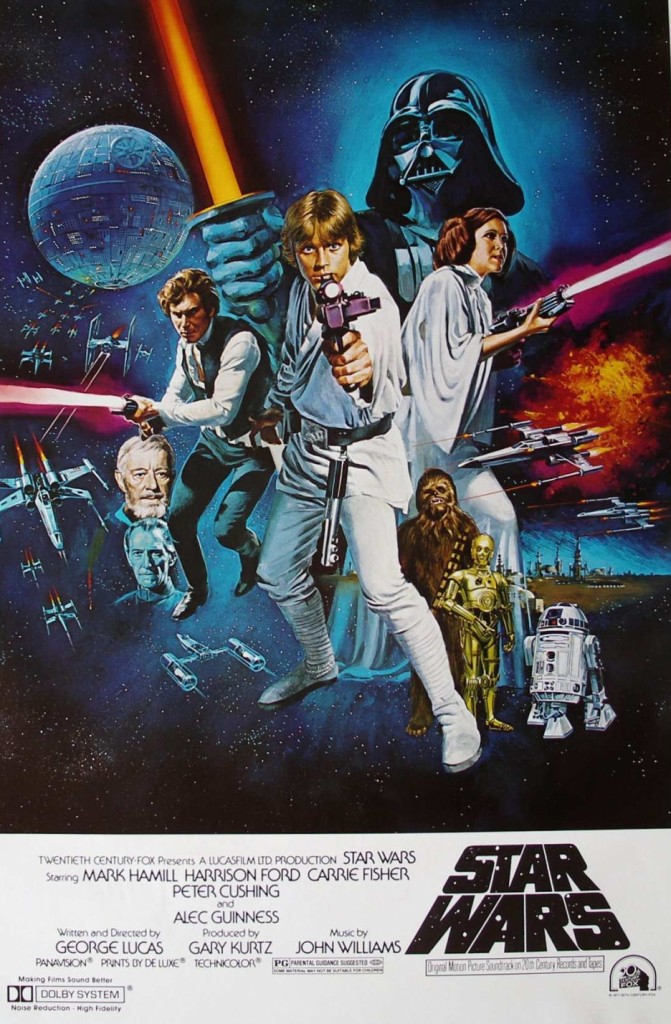
The one where it all began! In a dark time for the galaxy, the evil Galactic Empire rules over everything. The Jedi Knights, once the peacekeepers in the galaxy, have long been hunted down to extinction. As if things were not bad enough, the Empire has completed work on the Death Star, a massive space station that contains enough firepower to destroy entire planets. Over the course of the Empire’s reign, the Rebel Alliance, a small group of freedom fighters, continues to persevere against the seemingly impossible odds, wanting to restore freedom and democracy to the galaxy.
Princess Leia, an Imperial senator and secretly a member of the Rebel Alliance, has stolen the plans for the Death Star, hoping to get them back to the Rebels in an attempt to destroy the battle station, but is captured en route by the villainous Imperial enforcer, Darth Vader. Her droid companions escape with the plans and meet Luke Skywalker, a young man living on a moisture farm on a desert planet who learns he is the descendant of a Jedi Knight, and Obi-Wan Kenobi, one of the last surviving Jedi. The group joins forces with smuggler Han Solo and his brutish companion, the Wookiee Chewbacca, and sets off on an adventure to rescue the Princess and get the plans to the Rebellion. But evading the Empire and infiltrating their battle station is easier said than done!
This is the film that introduced the world to Star Wars. While it is admittedly a little dated compared to the sequels that followed, it revolutionized movie making and completely changed the way that Hollywood and cinema fans all look at science fiction. The massively positive critical reception help to save 20th Century Fox from financial problems, and turned George Lucas into a household name overnight. Troubled production did not stop the film from becoming hugely popular in multiple countries upon its release.
The movie has a nice balance of action, drama, and comic relief alike, all of which would become hallmarks for the series. There are admittedly a few parts of the movie that tend to drag; the early Tatooine scenes and much of what happens aboard the Death Star keep our attention but one cannot help but feel they could have been trimmed slightly. The same can be said of the final space dogfight, which while action packed does drag; it is clear Lucas and the crew wanted to throw every dollar into giving the viewers a gripping finale. That is not to say the film is not captivating and interesting throughout its length, though.
The other main issue I have with the first film is that this was George Lucas’ first attempt at Star Wars, and it tends to show throughout. The dialogue feels very clunky and generic compared to the two films that followed, and laughably campy at times. In particular, the Lightsaber effects are nowhere near as convincing or visually powerful as in the sequels. These do not derail the movie or ruin it by any means, but one will notice these things in comparison to the later movies.
Fortunately, the other aspects of the film hold up better. The story is simple and to the point and it works, largely helped by the opening “crawl text” that would become traditional for the series down the road. The movie admittedly feels more standalone than the other installments, but has since found its place as part of something much bigger. Lucas’ special effects and filmmaking techniques helped to make this a unique experience from start to finish. One who watches any documentary on the making of the film will see the extremes that the filmmakers had to go to in order to make this something truly unique.
The characters are one of the best and most endearing aspects of the Star Wars franchise, and George Lucas gets it right the first time around. We get plenty of comic relief in the form of the droids C-3PO and R2-D2, arguably the most recognizable characters associated with the franchise. Luke Skywalker is an interesting protagonist, who wants to break away from a mundane life on the moisture farm, only to find himself caught up in the middle of a full-on war, and tragedies that he is powerless to prevent. Alec Guinness is fantastic as the aged Obi-Wan Kenobi, who becomes Luke’s mentor figure that reveals to him secrets about the Force, and becomes a valuable ally. Of course, the true standout amongst the heroes is Harrison Ford’s Han Solo, a smooth talking smuggler who is initially only out for himself and a big pay day to escape his debts. The “love/hate” relationship between him and Carrie Fisher’s Princess Leia is priceless, and this element would be fleshed out even better in the immediate sequel.
Sadly, the “bad guys” do not get the same fleshing out as the heroes, though this does not stop them from having an imposing presence. Veteran actor Peter Cushing plays the villainous Grand Moff Tarkin. Overconfident and sly, he truly is the villain that you love to hate, and it is almost a shame that his major role is one film only. Darth Vader is physically portrayed by bodybuilder David Prowse, but it is the character’s voice, courtesy of James Earl Jones, that truly makes him terrifying.
The set pieces and locations only add to the overall atmosphere of the galaxy that Lucas was looking to create. From the deserts sands of Tatooine, which were shot mostly on location in Tunisia, to the Death Star’s corridors and chambers, no film before ever looked like this. It is not surprising that many filmmakers since have turned to this movie for inspiration, and continue to do so to this day.
The first Star Wars is not perfect, and does show its age in more than a few places. But it is a fantastic film that changed the face of cinema and movie making forever, and is a great beginning to this classic saga.
Trivia:
-This is the only film in the Classic Trilogy directed by George Lucas, though he did direct all of the prequels. This was his third feature film as a director, following THX 1138 and American Graffiti (in which Harrison Ford also appeared).
-Carrie Fisher, who portrays Princess Leia, was only 19 years old during filming.
-Luke Skywalker does not make his first appearance in the movie until nearly half an hour in. There were earlier scenes shot of Luke hanging out with his friends, and watching the space battle that starts the film through binoculars. While cut from the final film, they are referenced in other versions of the story (novelizations, comics, manga, etc.) It is widely believed that these were cut by Lucas so that the movie did not end up feeling like “American Graffiti in space.”
Changes from the original:
-The original 1977 theatrical release had no subtitle. “Episode IV – A New Hope” was added starting with the 1980 theatrical rerelease, when it was clear that there would be sequels. Even so, people do tend to refer to the first film simply as Star Wars to this day, and not by its subtitle.
-1997 Special Edition adds lots of creatures and other lifeforms to Tatooine, including additional Dewbacks to the Stormtroopers scenes as they hunt for the Death Star plans, and droids and aliens around Mos Eisley.
-The most infamous change in all Star Wars reissues was made in the 1997 Special Edition, in which bounty hunter Greedo shoots first in the conflict with Han Solo, prompting a fan uproar that still rages on to this day (Han shot first and killed Greedo in cold blood in the original release). The timing of their shots was made closer in later home video releases, but the damage was done.
-A major addition in the 1997 Special Edition is a scene where Han Solo talks to Jabba the Hutt before leaving Tatooine. The scene was shot in 1977 but not completed; a CGI Jabba is placed over the “stand in” actor the scene was filmed with. Jabba was reanimated in this scene for the 2004 DVD release, in a more detailed form.
-Writing that was in English in the original film is redone in the “Star Wars galaxy language” used in the sequels and prequels in the 2004 DVD release.
-Additional redone CGI footage of Rebel fighters on the approach to the Death Star.
Star Wars Episode V: The Empire Strikes Back (1980)
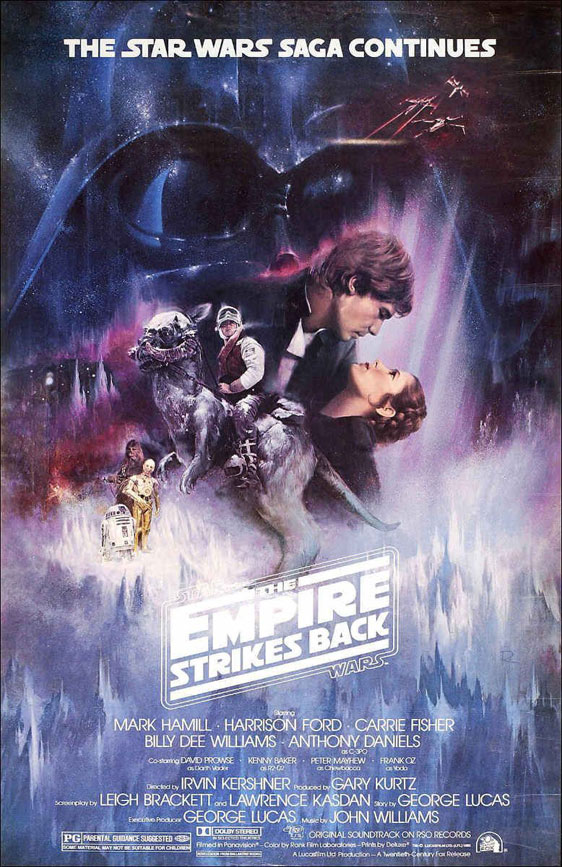
Three years have passed since Luke Skywalker destroyed the Death Star, and the Rebels have taken refuge on the icy world of Hoth, in a new base. Unfortunately, the defeat at the hand of the Rebellion has only strengthened the Empire’s resolve, and they have launched probes across space, scouting out the Rebels. Before long, our heroes find themselves on the run from the Empire once again, with Luke scouting out a mysterious swamp world to continue his training as a Jedi from Yoda, a master that once instructed his former mentor Obi-Wan Kenobi. Meanwhile, Leia, Han, Chewbacca, and C-3PO find themselves on the run from the Empire’s deadliest agents and bounty hunters. When the Empire catches up with our heroes, Luke must decide between whether to stay and finish his Jedi training, or rushing across the galaxy to rescue his friends.
The Empire Strikes Back is the definitive Star Wars movie. The first movie did a great job introducing us to the Galactic Civil War and the participants on both sides, but here we truly get to see these characters evolve and develop. Luke must face a journey unlike any he dealt with in the first film, trying to learn how to become a Jedi from Yoda, and struggling with a good deal of inner turmoil and obstacles that could prevent him from completing the training. Of course, Yoda himself first appeared here and quickly became one of the most popular characters in the entire franchise. The romantic love/hate relationship between Han and Leia is at its absolute best here, and with all of these developments going on with the characters, we are more than willing to forgive this film for being one that puts characterization first and action second.
Like the first film, the Empire’s villains do not quite get the same character development as the heroes, but the film does make greater strides than its predecessor does. We only see him via hologram and only in one scene, but this does mark the first on-screen appearance of Darth Vader’s Sith master, Emperor Palpatine (AKA Darth Sidious). Though the scene is brief, it does help us to gain perspective of things, and that there is even someone the mighty Vader is subservient to; the movie also succeeds in making it clear, particularly in its later moments, that Vader has his own agenda to keep and that he is not above defying his master’s wishes.
Some of the most classic moments in the franchise come from this film. The battle of the Rebel snowspeeders against Imperial AT-AT walkers. The asteroid field sequence. The sights of the swamp planet Dagobah and the strange beauty of Cloud City on Bespin. The first (on screen) Lightsaber duel between Luke and Darth Vader. And, of course, Vader’s classic revelation to Luke (chances are you know exactly what I am talking about, even if you are not a Star Wars fan).
The Empire Strikes Back endures with its reputation as the best film in the Star Wars franchise, and with good reason. Featuring some of the best character development and scenes in the series, it is no surprise that so many have been quick to name this one their favorite out of all the films. The film is absolutely worthy of its lofty reputation.
Trivia:
-In case the first film was a financial failure, George Lucas had an alternative, low-budget sequel in mind; this was obviously aborted when the first movie became an undeniable blockbuster. The story treatment for the original “low budget” sequel was adapted as a novel entitled Splinter of the Mind’s Eye, which came out in 1978.
-Irvin Kershner, who directed the film, was one of George Lucas’ professors in film school. Kersh was initially skeptical about directing the film, as sequels at the time were not generally looked upon favorably.
-Leigh Brackett is given a writing credit for the film, though almost none of her script made it into the final film. She died of cancer before the film’s release, and the writing credit is meant as a tribute to her and her hard work, even though little of it was actually used.
-The ill-fated Imperial Admiral Ozzel is portrayed by Michael Sheard. This was Sheard’s best known feature film role. He had also portrayed Adolf Hitler five times in his career, most notably in a classic scene of another LucasFilm production, Indiana Jones and the Last Crusade.
-Harrison Ford ad-libbed Han Solo’s infamous “I know” response when Princess Leia says she loves him in the carbon freezing chamber.
Changes from the original:
-In the 1997 Special Edition, additional footage is added of the Wampa ice creature in the cave, following its attacking and capturing Luke early in the film.
-In the 2004 DVD release, the scene of Darth Vader conversing with the Emperor is completely rerecorded with alternative dialogue, and Ian McDiarmid playing Palpatine (who played the character in the sequel and all of the prequels). The original version of this scene (present in the original release and the 1997 Special Edition) featured a woman playing the Emperor, wearing a special mask with monkey eyes superimposed on it, voiced by Clive Revill. Despite this, subsequent versions of the film still credit Revill as the voice of the Emperor.
-Cloud City is opened up more in the 1997 Special Edition; you can see more of what is going on, and get a better look at the cloud scenery.
-1997 Special Edition adds a scene of Darth Vader boarding his shuttle in Cloud City and returning to the Executor. The “boarding the Executor” footage is actually an outtake from Return of the Jedi, when Vader first arrives at the second Death Star.
-Boba Fett’s voice is redubbed in the 2004 DVD release, making it identical to Jango Fett’s voice in the Prequel Trilogy.
Star Wars Episode VI: Return of the Jedi (1983)
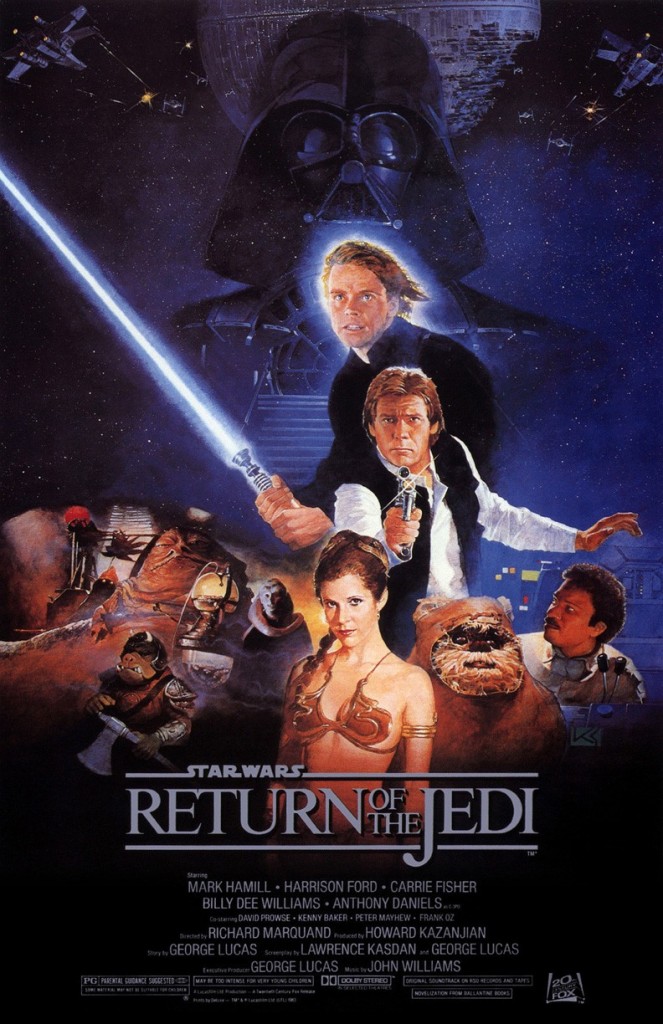
The third and final film of the Classic Trilogy! Following a harrowing mission to rescue Han Solo from the vile gangster Jabba the Hutt, our heroes reunite with the Rebel Alliance in anticipation of a forthcoming battle. But the stakes are higher than ever. The Empire has begun work on a second Death Star, even larger and more powerful than the original. With both Darth Vader and the Emperor aboard the new battle station, this is the time for the Rebels to strike with one swift stoke, and end the Galactic Civil War once and for all. But little do the Rebels know they are being lured into a trap by the Emperor, who plans to use the power of the new battle station to eradicate the Rebellion.
And this is how it ends. Return of the Jedi is a very good film overall, though certainly a little uneven and imbalanced when compared with its predecessors. On a positive note, the character arcs begun way back in A New Hope come full circle here, by the time it is all said and done audiences will be more than happy with the way that these characters have developed. The climax and its conclusion do not disappoint, and the film ends on a happy, optimistic note that does not feel artificial or contrived. Action packed and filled with epic battles on the land and in outer space alike, Return of the Jedi is a worthy conclusion to the Classic Trilogy.
The opening scenes at Jabba’s Palace, in which our heroes must rescue Han Solo, are arguably its most entertaining moments (and not just because of getting to see Princess Leia in what is more or less a bikini, but that is certainly a highlight as well). The suspense remains high throughout this portion of the film, with danger looming for all of our heroes. Scenes that follow on the Forest Moon of Endor, in space, and for Luke Skywalker aboard the second Death Star, do not disappoint either. In particular, Luke’s battle against Darth Vader and the Emperor is a memorable series of events, largely because of an unexpected conclusion that manages to end things on a high note, redeeming one of the series’ most detestable villains.
That said, as much as I like Return of the Jedi, it does not quite hold up to the films that came before. There are even more pacing problems here than there were in the original film; there is always something going on but one cannot but help if the film could not have benefited from some additional editing. The biggest problem here, of course, is the Ewoks, the primitive “teddy bear” race on the Forest Moon of Endor; they feel like an attempt to make the movie more “child friendly.” Are we really supposed to believe that a race of cutesy Muppets helped to defeat the Galactic Empire, who hunted down and killed the Jedi Knights and blew up Alderaan? These points are debatable, of course. A few minor flaws certainly do not derail the movie.
Trivia:
-Scenes were filmed of Luke constructing his new (green) Lightsaber and of Vader force choking Moff Jerjerrod when Vader is denied access to see the Emperor, but these were never used in any version of the final released film. The Lightsaber scene first appeared (officially) as a bonus feature on the 2011 Blu-ray release.
-In trailers for the film, Luke wields a blue Lightsaber like he used in the previous films. Its color was changed to green in the final film because the blue one did not look as good against the blue skies during the Tatooine battle outside of Jabba’s sail barge.
-Despite playing a pivotal role in the film, the Ewoks are never referred to by that name at any point in the film (other than the credits). Moff Jerjerrod is never referred to by name, and the Emperor is never called “Palpatine.”
-Kenneth Colley portrays Imperial Admiral Piett. He is the only actor to play an Imperial officer in more than one film. Another random noteworthy role of Colley is Jesus Christ in the classic 1979 Monty Python film, Life of Brian.
-Originally, the planet that was supposed to be Endor in the final film was supposed to be a Wookiee planet. This was supposedly aborted for budget reasons, with the Ewoks becoming a low-budget substitute of sorts.
-The only Rebel pilot to survive all three Classic Trilogy films is Wedge Antilles, portrayed by Denis Lawson (Luke Skywalker survives all three films but does not participate in a dogfight in Return of the Jedi). Lawson’s nephew, Ewan McGregor, portrays young Obi-Wan Kenobi in the Prequel Trilogy.
Changes from the original:
-In the 2011 Blu-ray release, the Ewoks have new CGI eyes and can blink.
-In the 1997 release, many scenes are added to Jabba’s Palace. The Max Rebo Band is redone in CGI and performs a different musical number than they did in the original theatrical version. Femi Taylor, who portrayed Oola the slave girl in the Jabba scenes, returned to reprise her role for additional footage, including scenes of her in the Rancor pit. Additionally, the Sarlacc is given a beak and additional tentacles.
-On the 2011 Blu-ray release, Darth Vader yells “Nooooo!” when he sees Luke being tortured with Force lightning by the Emperor, when he redeems himself.
-1997 Special Edition adds in scenes of Bespin, Tatooine, and Coruscant celebrating the death of Darth Vader and the Emperor. 2004 DVD adds a similar scene of Naboo, and adds the Galactic Senate and Jedi Temple to the Coruscant footage. The final piece of music in the movie prior to the credits is changed to compensate for this addition.
-At the end of the 2004 DVD release, the elderly Sebastian Shaw is replaced by Hayden Christensen in the role of Anakin Skywalker’s Force ghost (Christensen played the role of Anakin Skywalker in the prequels).
Star Wars Episode I: The Phantom Menace (1999)
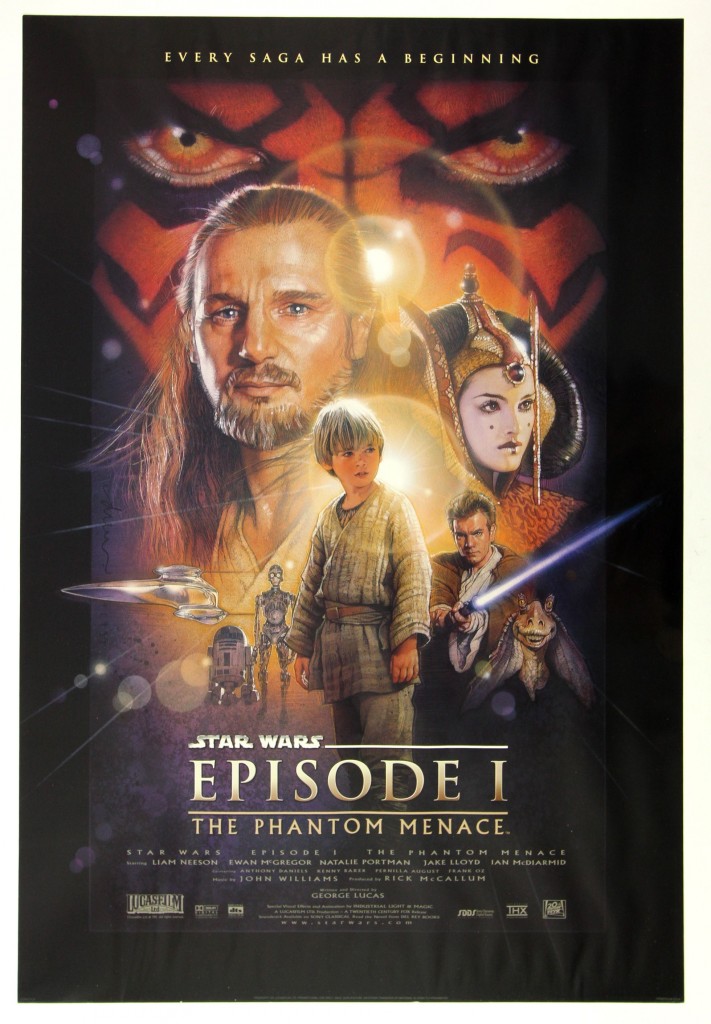
Set three decades prior to A New Hope, The Phantom Menace is the first film in the Prequel Trilogy. The villainous Trade Federation has allied with the Sith Lord Darth Sidious, prompting the Galactic Republic’s Supreme Chancellor Valorum to send Jedi Knight Qui-Gon Jinn and his apprentice, Obi-Wan Kenobi, to investigate. The pair of Jedi quickly find themselves in over their heads, protecting planet Naboo’s Queen Amidala against the Trade Federation’s battle droids. When the Jedi and newfound ally Jar Jar Binks escape with the Queen, Sidious sends his ruthless and lethal enforcer, Darth Maul, to deal with them. Upon their arrival to a desert world in the Outer Rim, the group meets a mysterious young slave boy strong in the ways of the Force, who may play eventually play a large part in the fate of the galaxy.
Let us get the unpleasant sentiments out of the way first – this is, by far, my least favorite Star Wars film. Jake Lloyd is tragically miscast as the young Anakin Skywalker. Jar Jar Binks is annoying as sin. The childish humor (including toilet humor) makes certain parts of the movie feel like a big joke. The Trade Federation plot makes no sense. At large I got the idea that George Lucas was trying to create something more “kid friendly” than the Classic Trilogy, yet also trying to create something intelligent and thought provoking. The end result here is uneven, scattershot, and is not surprisingly shared in the mind of many a fan as the weakest Star Wars film.
That said, the film is not a total loss, and there are more than a few reasons to watch it. The master/student relationship between Qui-Gon and young Obi-Wan makes for an interesting dynamic; it is a shame we never fully get the chance to bond with Qui-Gon like some of the other characters in the series, as Liam Neeson beautifully portrays the aging Jedi. The battle scenes, in particular those involving Lightsabers, are absolutely spectacular; 16 years worth of movie making tech advancing enabled Lucas and company to create a gorgeous looking film with phenomenal effects. The podrace, while overlong, definitely keeps the audience’s attention. The largely silent and menacing Darth Maul makes for a memorable villain, but like Qui-Gon, it is a shame we do not get to see him in later feature films. The one thing criminally missing from the film is space combat scenes; what little we get is minimal at best, and does not come close to the epic nature of those in the Classic Trilogy.
It has its share of cringe worthy moments and is far from the franchise’s finest hour. But The Phantom Menace is still a decent film overall. Fans may have overexpected what they would get after 16 years without a Star Wars movie, hence the abundance of scathing reviews. But the film is not as bad as so many would lead you to believe. It is worth viewing again, contrary to popular belief.
Trivia:
-The novelization for the film was written by legendary fantasy author Terry Brooks, and included a number of scenes that did not make it into the finished film.
-When filming scenes as young Obi-Wan, Ewan McGregor made “Lightsaber noises” with his mouth, which had to be removed in post-production.
-When George Lucas made the prequels, he ignored the existing Expanded Universe, not considering those stories to be canon or official (and the old Expanded Universe has since been deemed non-canon at large). One major exception to this was the name Coruscant, which is the central world of the Galactic Republic (and later the Empire) which was first given that name in a novel by Timothy Zahn in 1991.
Changes from the original:
-Additional podrace footage is added to the 2001 DVD release.
-An “Air Taxi” scene that was cut from the theatrical version is reinstated in the 2001 DVD release.
-2011 Blu-ray release replaces the puppet Yoda with a CGI one, maintaining consistency with the latter two prequels.
Star Wars Episode II: Attack of the Clones (2002)
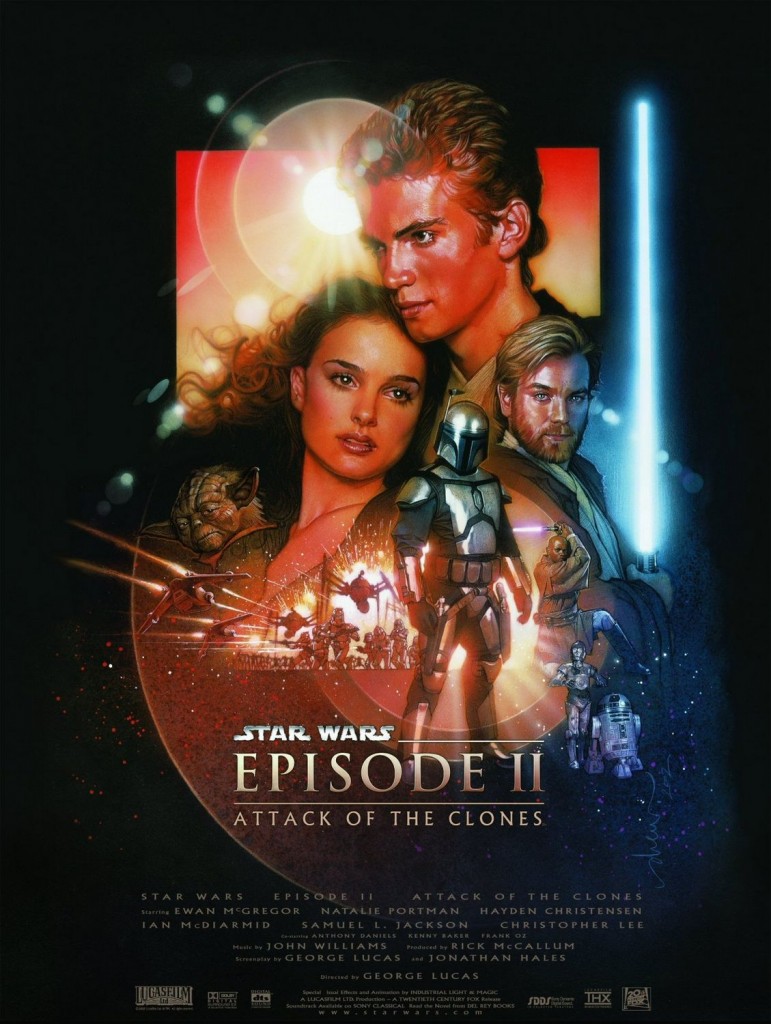
A decade has passed since the events of The Phantom Menace. Count Dooku, once a great Jedi, has taken several systems and seceded from the Galactic Republic, forming the Confederacy of Independent Systems. As such, the Republic is now on the verge of a full scale war. Returning from setting a conflict, Obi-Wan Kenobi, with Anakin Skywaker now serving as his Padawan learner, are assigned by protect Senator Amidala, the former Queen of Naboo. But before long, our heroes discover a mysterious conspiracy regarding a bounty hunter and the manufacture of a Clone Army, supposedly for the Republic’s use. It is up to the Jedi Council to uncover Dooku’s true motives, and do what is necessary to stop the conflict from becoming widespread. Meanwhile, Anakin finds himself at odds between his Jedi training and his feelings for Amidala.
I have split feelings in regards to Attack of the Clones. On one hand, the film rectifies many of the problems with The Phantom Menace. We get far less Jar Jar, more battle scenes, more of the Jedi, and more of the galaxy at large. On the other hand, the direct plot of the film is even more confusing than that of Episode I, and the cringe worthy wooden dialogue and overextended romantic scenes threaten to derail the film and kill what momentum it has built up. George Lucas is a great producer and “idea guy” but his shortcomings as a director and a writer rear their ugly heads on more than a few occasions here.
Fortunately, the good does once again tend to outweigh the bad. These are truly epic action scenes, and they come in various forms. Like the previous film, there are not enough space combat scenes, although a “space chase” scene through an asteroid belt between Jango Fett and Obi-Wan Kenobi does a good enough job entertaining the audience. The climactic battle scenes on Geonosis at the film’s climax are some of the best in the Star Wars franchise, and a certain little green guy gets a chance to show off his Lightsaber skills! Christopher Lee is superb as Count Dooku, the villainous Separatist leader, and he gives what is arguably the movie’s most memorable performance.
This is not a great film, though it is superior to Episode I, and is still worth checking out. It moves the Prequel Trilogy along well enough, and does give the story some major development, even if certain elements of the plot do not get developed as well as they should. If you can overlook things like the terrible dialogue and the poor pacing in certain scenes, it is a satisfying film overall.
Trivia:
-Anthony Daniels, who plays C-3PO, makes a cameo in the Coruscant bar scene early in the film out of costume.
-There were going to be Jedi using yellow Lightsabers on Geonosis, but this was later aborted as the yellow blades did not look good on the red, dusty world on film.
Changes from the original:
-The IMAX release in November of 2002 actually cut several scenes out of the movie, roughly 20 minutes worth.
-The DVD release makes some very minor changes, mostly visual and dialogue oriented, to a few scenes.
Star Wars Episode III: Revenge of the Sith (2005)
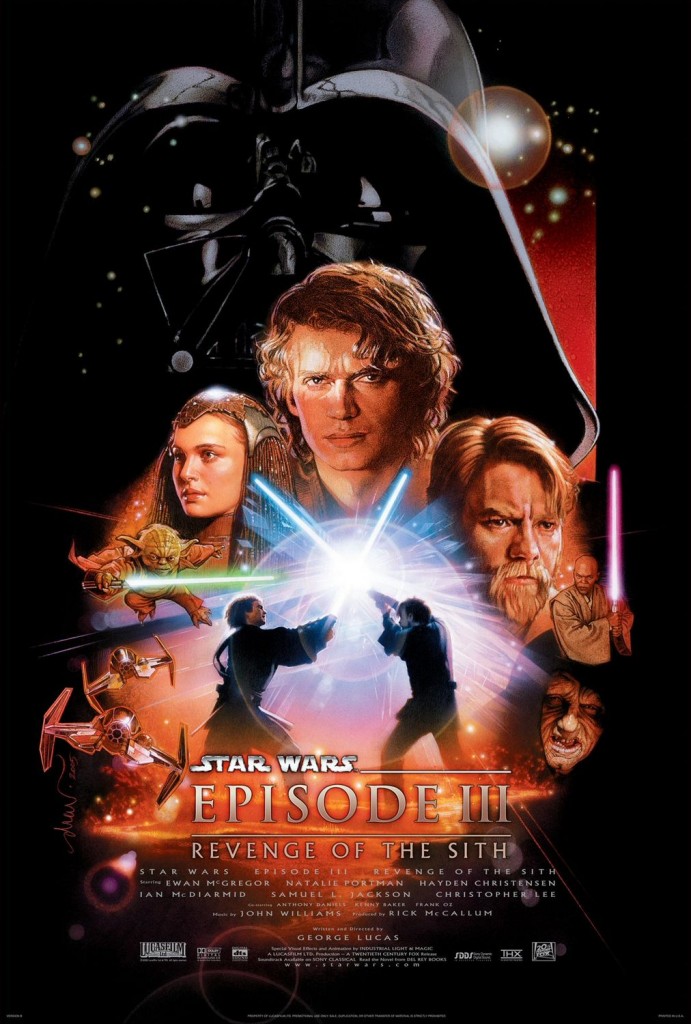
The final film of the Prequel Trilogy. Three years after Attack of the Clones, the Clone Wars have been spreading across the galaxy, with the Republic and the Separatists fighting each other at their absolute hardest on multiple worlds. Anakin and Obi-Wan are fighting alongside one another against impossible odds, with the Separatist leaders Count Dooku and General Grievous remaining a threat. Following a mission to rescue Supreme Chancellor Palpatine, Anakin is troubled by visions of Padme’s impending death, which he vows to prevent. When Obi-Wan goes to another world to pursue Grievous, Anakin is continually troubled by these visions and is disillusioned by being neglected by the Jedi Council. This sets into motion a series of events that starts Anakin down a path he believes will enable him to save his wife and gain greater power, but one that will forever dominate his destiny and have lasting and unexpected repercussions, culminating in an epic duel between master and student.
I love the Classic Trilogy, but found Episode I and Episode II to be largely hit and miss films. Revenge of the Sith does have a few problems, but it is a far superior product to those movies. The stakes are higher, the action scenes more intense, and the mood far darker and more ominous than any other Star Wars film. It is also worth mentioning that this is the first Star Wars film to be rated PG-13 rather than PG for those very reasons, and likely for a very gruesome scene featured near the end of the film; long time fans of the franchise know exactly what I am talking about.
One of the biggest problems I had with the first two prequels was an almost complete lack of space combat scenes. That is almost immediately rectified by this movie’s opening scene; the biggest and most epic dogfight a fan could want. The movie starts fast and never lets up during its two hour plus duration. There is an almost complete absence of comic relief in this film, but if anything, this fan sees that as a good thing.
The battle between Obi-Wan Kenobi and Darth Vader has long been an infamous moment of Star Wars lore, but this was where it finally came to life on the big screen. It is the longest, lengthiest, and most intense battle in any Star Wars film, and the ending is suitably gruesome and disheartening. We even get to see the Emperor participate in a few battles, and once more, everyone’s favorite green guy gets a chance to pick up his Lightsaber.
The only major weakness that pervades in Revenge of the Sith is the same problem I had with Attack of the Clones – terrible dialogue and cringe worthy romantic scenes. Fortunately, these scenes are kept to a comfortable minimum here compared to the previous movie. There are some unanswered questions and some scenes that could have been fleshed out a little more, as well as some that could have been omitted entirely, but overall at large there are not nearly as many problems here as there were in the prior prequels.
The prequels received a mixed reception, but this fan was glad to see Lucas and company kick things into high gear for the final installment. It closes up the Prequel Trilogy beautifully, even if there are a few loose ends. It is also the only prequel that approaches the Classic Trilogy in terms of overall greatness. Fans should not be disappointed by Revenge of the Sith.
Trivia:
–Star Wars creator George Lucas cameos as blue-skinned Baron Papanoida at the Coruscant Opera House.
-Gary Oldman was supposed to voice General Grievous but dropped out as the film was being made outside of the Screen Actor’s Guild, of which he is a member. Matthew Wood ended up voicing the character, and would also voice the character on The Clone Wars animated series.
-There was supposed to be a scene in the film featuring Liam Neeson reprising his role as Qui-Gon Jinn as a Force ghost, communicating to Obi-Wan and Yoda, but no such scene was filmed or included in any version of the movie. A similar scene does appear in some other tellings of the story, though.
-The Clone Trooper whose platoon serves with Obi-Wan is named Commander Cody. This is a reference to the classic comic character Commando Cody. It is NOT a reference to the rock band Commander Cody and the Lost Planet Airmen, contrary to popular belief.
Changes from the original:
-2011 Blu-ray release adds additional dialogue for the Clone Troopers when they arrive on Utapau.
All six Star Wars films are worth viewing, even if the prequels do have their share of unfavorable moments here and there. With The Force Awakens releasing in a week, there is no time like the present to start your Star Wars marathon!
Star Wars, all films, all associated properties, sequel films, and images are copyrighted to George Lucas, LucasFilm, 20th Century Fox, Disney, and all other related entities.

